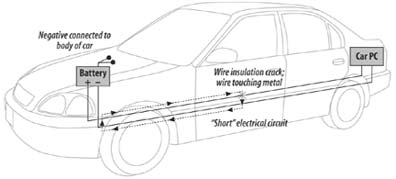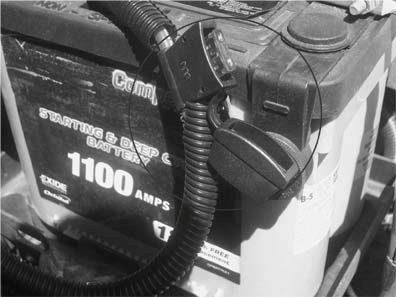Hack2.Prevent Electrical Fires
Hack 2. Prevent Electrical Fires
Only you can prevent electrical fires (as the paraphrased saying goes), and fuses are an essential form of prevention. In any electrical system, it's important to protect against miswiring that can result in device damage or even fires. This hack explains voltage, amperage, and power levels, and points out several of the safety features (i.e., fuses) of your automobile's electrical distribution system. 1.3.1. Amps"Understand Car Electrical Systems" [Hack #1] defined voltage as the amount of potential or pressure behind electrical flow, and gave the analogy of a high- or low-pressure hose. To explain current in terms of water, we would be considering how many gallons of water went through the hose per hour. A very unscientific conceptual definition of electrical current (measured in Amperes, or amps not to be confused with sound amplifiers!) is simply how many gallons of electrons pass through the wire per hour. It's pretty simple: if you're trying to power a small device, such as a light in your car, you only have to give it a few teaspoons (milliamps, or mA) of electrons every hour. If you're trying to power your car radio, you need a cup of electrons every hour (amps, or A). If you're tooling around town in your electric car, that's where the gallons of electrons (kiloamps, or KA) come in. To continue our simplified analogy here, the more amps you need for your device, the bigger your "hose" or wire should be. "Gauge Your Wires" [Hack #3] discusses the different sizes of wire and how thick they should be for a given application. 1.3.2. FusesFuses are protective devices placed along the path of an electrical circuit. To fuse means, basically, to melt. Fuses melt to protect the circuit, wires, and devices when you put too much current (electrons per second, or amps) through them. You usually get too much current going through a wire because of a short circuit, which is when wires that shouldn't be touching touch. In a short circuit, the electricity that is supposed to go all the way to some device, such as a radio or light bulb, takes a direct path back to the battery. In other words, if the wire that is trying to bring 12V to the device gets loose and touches some metal in the car, the electricity tries to take a shortcut back to the battery through this metal (a "short" circuit, shown in Figure 1-6). Because this shorter circuit has no device to use the electricity, the energy simply heats up the wires, and if there is no circuit breaker or fuse, the wires will melt and possibly cause a fire. Figure 1-6. A short circuit To protect against this situation, a fuse of a specific amp rating is put in the line between the battery and the device it powers, close to the battery itself. If a short circuit develops in the wiring or if the device malfunctions, the fuse simply melts once the amps get too high. Automobile fuses come in several different varieties. There are small and large blade-edge fuses, small cylindrical fuses, and plastic fuses with metal strips. There are also fusible links, which look like wires but will melt like fuses at the rated current, as well as circuit breakers, which can be reset without replacement after the short circuit is repaired. If you're installing new fuses in the car, you can use either the very common blade-edge fuses or whichever ones your car already uses (so you can share the spares). There is usually a location in the car where most of the fuses go, called the fuse box. It may be found under the hood, inside near the driver's ankles, in the glove compartment, in the trunk, between the dashboard and the door, or in some other location, depending on the car. As you can see in Figure 1-7, the fuse box contains a large number of fuses, each protecting a section of the car or a particular device, such as the radio, headlights, tail-lights, A/C unit, and so on. If the dashboard lights won't turn on even though the rest of the car seems fine, chances are the fuse has melted. Figure 1-7. A fuse box The manual that came with the car when it was purchased new, or a Haynes or Chilton's manual from any Pep Boys, should tell you the layout of the fuses in your car's fuse box and the proper amperage ratings of these fuses. Many cars have this diagram right next to the fuse box itself. Fuses are rated for different amperages, and you should use a fuse just above the amperage that the device will draw. If a device is designed to draw 5A normally but can spike to 8A when it first starts (common for situations where a mechanical arm or switch activates at first, such as a CD loader or motor), it would be safe to use a 10A fuse for the device. If you used a 20A fuse and the device short-circuited internally, the 20A fuse would be very slow to "blow" or melt and would probably not save the device from further damage. The 10A fuse would start to melt as soon as the current went over the normal level, largely protecting the device and the wires that bring it power and possibly preventing a fire in your car.
1.3.3. Protecting Your Devices with FusesAlthough the car has its own set of fuses, you may add devices that bypass the normal car power. Perhaps your power line goes straight to the battery, or your device connects, along with a lot of other devices, to a 20A fuse. You don't want a short circuit on your device to take out the fuse for all the gadgets in your trunkyou'd like to be able to tinker with your amplifier or car computer and know that you'll be able to conveniently replace the fuse right there if you accidentally cross wires. You can insert a fuse anywhere you want using an in-line fuse connector (the "in-line" refers to the fact that you put the fuse wire in a line between your battery and the device it protects, as in Figure 1-8). It's generally better to put the fuse closer to the power sourcethat way, the length of the wire run is protected by the fuse.
In-line fuses are available at hardware shops, car stereo shops, Pep Boys, and similar locations. To use them, simply choose the lowest fuse rating that will still pass enough power to your device at its peak power usage, and then connect the fuse wire between the power source (i.e., the battery or wherever you are getting your 12V) and the device. Figure 1-8. An in-line fuse Here are some important tips for in-car wiring:
If you need help on wiring, see "Connect Your Wires" [Hack #4]. |
